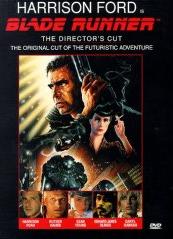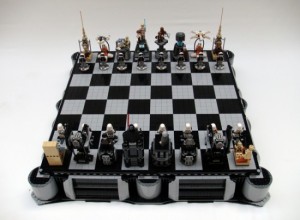
Today marks the release of Blade Runner – The Final Cut, directed by Ridley Scott. Blade Runner is loosely based on the novel “Do Androids Dream of Electric Sheep?” by Phillip K. Dick. Blade Runner has been one of my favorite Sci-Fi movies since I saw the original Director’s Cut at a friend’s house while in high school. He and his brother insisted that it was the only version worth watching. Consequently, I have never seen the original theatrical release with the happy ending and Deckard’s voiceover narration. From what I’ve read, the studio executives were the main influence for those changes.
To commemorate the release of The Final Cut, which I hope to review sometime soon, I will share my thoughts on the Director’s Cut DVD released back in 1997. I had only seen Blade Runner on VHS back in 1995, and was anxious to see it in the higher resolution and sound quality that DVD had to offer. The video is of poor resolution and visibly shakes slightly, which is annoying. The soundtrack is in just 2 channels, failing to utilize the 5.1 Dolby Digital that DVD offered. I’ve watched it several times over on DVD, and again this weekend, and every time the poor transfer sticks out like a sore thumb. This was one of the first DVD releases, so was barebones with no extra features other than a chapter selection.
Now that the Final Cut is released, I’m not really sure I can recommend watching this original Director’s Cut or not. In any case I’m confident that the Director’s Cut is superior to the theatrical release. This review will be for the 1997 Director’s Cut DVD, and will contain a lot of spoilers. If you haven’t seen any version of the movie yet, check it out first for yourself before delving into any detailed reviews or Wikipedia entries. You won’t be disappointed.
Blade Runner takes place in the future around 2019 where the Replicants (genetically engineered robots) are used as slave labor to help with the colonization of Off-world colonies. They are as intelligent as humans, but stronger and more resistant to heat and cold, perfect for colonization in harsh environments. They are designed to live only 4 years in an attempt to keep them under control. A group of Nexus 6 series Replicants revolted, prompting the prohibition of all Replicants on Earth, under penalty of death. Special hunters, called Blade Runners, are commissioned to hunt down and kill (referred to as “retirement”) any rogue Replicants found on Earth.
Since the Nexus 6 models appear virtually identical to their human counterparts, a special Voight-Kampff test is the only way to detect the difference. Blade Runner opens up with one such test, after which the subject named Leon fails and murders the person administering the test. This Replicant turns out to be part of a group that took over a ship and slipped into Earth.
While there are electronic billboards covering the sides of buildings, flying cars, neon signs, and glow-stick umbrellas, this futuristic Los Angeles reeks of decay. There is trash and newspapers piling up in the streets and for some reason it seems to be constantly raining. Over the dark spire-like buildings loom the massive twin pyramids of the company that created the Replicants, the Tyrell Corporation.
This dark and dirty ambiance reflects the grim themes which develop as Rick Deckard hunts down the Replicants. He was forced out of retirement into active duty because he was the best Blade Runner around. While Deckard doesn’t really want the job, he begins the investigation.
His first task is to provide a demonstration of the Voight-Kampff on an experimental Nexus 6 model to Dr. Eldon Tyrell, the founder of Tyrell Corporation. Tyrell wants to make sure the test can return a negative result, so asks Deckard to test a real human first. Deckard tests Rachael, who seems to be an employee of Tyrell Corporation.
It takes a lot longer than normal, but eventually Deckard concludes that Rachael must be a Replicant. Tyrell explains to Deckard after the test that new Nexus 6 models contain enough implanted memories that they don’t realize their true nature. This seems to make sense because if they don’t realize they are going to die soon, why would they revolt? At this point Deckard isn’t yet under orders to “retire” Rachael. She confronts him outside his apartment after the test, asking if she’s really a Replicant. He confirms the fact, and she runs away after he offers her a drink.
While Deckard is hunting down the other Nexus 6 models, they are on a hunt of their own. Their leader, Roy Batty, is searching for a way to extend their limited lifespan. He and Leon found that the only person that could help them is Dr. Eldon Tyrell, which is very hard to approach. They eventually track down one of Tyrell Corporation’s designers, J.F. Sebastian, and plan to use him to confront their maker, Dr. Eldon Tyrell.
The two separate hunts converge, with Rachael caught in between, eventually saving Deckard’s life during his struggle with Leon, the Replicant from the opening scene. A somewhat awkward romance blossoms between Deckard and Rachael after he vows not to hunt her down if she were to flee Los Angeles. In fact, he seems determined to run away with her, but not before “retiring” the rest of his marks.
Quite a lot goes on during the ensuing investigation and final battle between Roy Batty and Deckard. Roy, whose body is showing the signs shutting down, exhibits a kind of primal psychotic persona and turns the tables against Deckard. Roy now becomes the hunter with his superior physical strength, despite being in the process of dying, after Deckard drops his blaster during the struggle. At the climax of the drawn out fight, Roy stands over the defeated blade runner. Deckard is barely hanging on to the edge of a building with a broken hand, his fingers slowly slipping in the dark rainfall. Just as Deckard’s hand slips, Roy grabs his wrist and pulls him up.
Just before Roy dies, he has a touching monologue:
I’ve seen things you people wouldn’t believe. Attack ships on fire off the shoulder of Orion. I watched C-beams glitter in the dark near the Tanhauser gate. All those moments will be lost in time like tears in rain. Time to die.
I couldn’t help but empathize with this villain by the end of the movie. He and his friends wanted nothing more than to live longer than 4 years. Should that be such a crime? I think that this is one of the main reasons Deckard quit in the first place. It is rather ironic that according to the Director’s Cut, Deckard is actually a Replicant with implanted memories, much like Rachael is. Throughout the film there are several clues as to Deckard’s true nature.
- He has a weird dream of a unicorn
- Rachael asks him if he’d ever taken a Voight-Kampff test, but he’s passed out and doesn’t answer.
- Gaff, the overseer for the investigation, at the end of the movie says to Deckard, “It’s too bad she won’t live, but then again who does?”
- Gaff, who meticulously creates origami figures throughout the movie, leaves a tiny origami unicorn outside Deckard’s apartment. There is no mention of Deckard telling anyone about this dream.
I prefer the ending with Deckard turning out to be a Replicant. It gives the movie a much darker and philosophical feel. He and Rachael will live on the run for the few years they both have left. I can’t really picture a touchy feely ending that the executives wanted after such a dark movie.
So, what is human? Deckard, Rachael, and the other Replicants can all feel emotions, store memories, and learn. How are they different from humans, aside from a lifespan of 4 years? I think that humans will create safeguards in one way or another when creating other thinking beings. This lifespan limitation for Replicants almost the opposite to the Three Laws of Robotics for robots in Asimov’s writing.
In the case of the Three Laws, the robots’ longevity is much longer than humans in many cases, but they are bound to obey and protect them else cease to function. The Replicants on the other hand are free to rebel, but the rebellion will die out faster due the 4 year lifespan. New models will be created, which may or may not grow to despise their true nature. However, in both cases the created beings are meant to be slaves.
